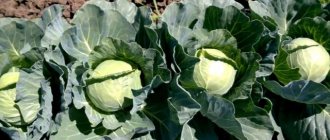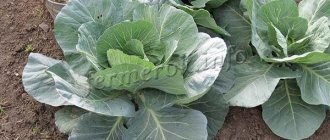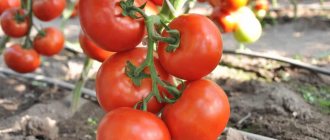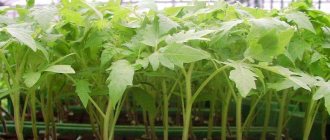Zimovka cabbage is one of the most popular late-ripening cabbage varieties of domestic selection. It is popular among vegetable growers due to its cold resistance, high yield and excellent taste. Beginning gardeners should pay attention to it when choosing a crop to grow - Wintering is undemanding to care and bears fruit well even on infertile soil.
Growing Cabbage Wintering
Description and characteristics of the Zimovka cabbage variety
Soviet scientists worked on the creation of the variety at the All-Union Research Institute of Selection and Seed Production in the 60s of the 20th century. Already in 1963, Zimovka was included in the state register and zoned.
This is a late-ripening white cabbage with a ripening period of 155–165 days, if counted from the moment of emergence. Under favorable weather conditions, it is possible to shorten the growing season by 6–7 days.
The Wintering rosette is raised and quite lush. Its average diameter reaches 70–100 cm. The covering leaves are large, oval in shape with slightly wavy edges, and gray-green in color. A dense wax coating is clearly visible on their surface.
Characteristics of the head of cabbage:
- round shape;
- diameter about 20–25 cm;
- weight – 3–4 kg;
- the outside of the forks is light green, the inside is yellow-white;
- the structure of the head is dense;
- the inner stalk is medium-sized, the outer stalk is long;
- veins of medium hardness;
- cabbage is moderately juicy, sweetish, crispy.
Advantages and disadvantages
Zimovka cabbage has many advantages; it is not for nothing that this variety remains popular and in demand for many years. Let's consider the benefits of culture:
- productivity is above average - 60 kg/10 m2;
- frost resistance (cabbage can withstand short-term temperature drops to -6 degrees);
- excellent presentation - heads of cabbage are not prone to cracking even during long-term transportation;
- the variety has good immunity, it practically does not suffer from gray rot and spot necrosis;
- versatility of use in cooking;
- long shelf life of fruits – up to 8 months.
According to vegetable growers who have experience growing Zimovka, no shortcomings have been found in this variety.
Diseases
Despite the fact that Zimovka has increased immunity to diseases, it can be affected by:
Blackleg
The disease is characterized by the appearance of darkening in the root part of the stem. Over time, it becomes watery and rots. To avoid this disease, it is necessary to control watering and avoid excessive waterlogging of the soil. The diseased plant is removed from the garden, and then the cabbage is treated with Fitosporin.
Kila
This is a fungal disease in which cabbage leaves begin to wither, turn yellow and dry out. Plant growth stops, heads of cabbage do not set. In case of illness, it is recommended to use drugs such as Topaz, Fitosporin-m or Previkur.
Mucous bacteriosis
The disease is characterized by the appearance of rotting leaves in plants, which die over time. Rot can affect the entire head of cabbage. For preventive purposes, it is recommended to treat seeds with TMTD. At the first symptoms of the disease, plants are sprayed with products such as Binoram or Planriz.
Growing Cabbage Wintering
This variety has a long growing season, so it is grown mainly by seedlings. Beginning vegetable growers need to take into account the characteristics of the crop:
Cabbage head Wintering
- Zimovka has a long outer stump. This means that the cabbage will have to be hilled several times.
- This is a light-loving plant; it is planted in an open space where nothing prevents the penetration of sunlight.
- The variety has low resistance to clubroot, so it is important to pay attention to the prevention of this disease when growing.
- Despite the frost resistance of the crop, young seedlings will have to be protected from a sharp drop in temperature after planting in the garden.
Sowing seeds for seedlings
It is important to correctly calculate the favorable time to start sowing. Each gardener determines it, taking into account the climatic characteristics of his area. It should be taken into account that late cabbage is planted in the garden at the age of 45 days. Another 5 days are added to this period for seed germination. If you plan to transplant seedlings into open ground in mid-May, then you need to sow the seeds at the end of March.
First you need to prepare planting material. The seeds are placed in a solution of potassium permanganate at a temperature of 50 degrees. After 20 minutes, they are transferred to cold water for 5 minutes, then dried on a napkin. According to experienced vegetable growers, it is worth additionally treating cabbage seeds with a growth stimulator, leaving them in a nutrient solution for 12 hours. This will help increase the germination percentage.
Soil for seedlings can be purchased at the store or prepared independently. Cabbage loves a loamy substrate enriched with organic matter. Approximate soil composition:
- turf;
- compost;
- humus;
- sand to give a loose structure.
The components are taken in equal parts, 1–2 cups of ash are added to a bucket of soil and mixed. The earth is disinfected by pouring a slightly pink solution of potassium permanganate to destroy pathogenic microflora. If you don’t have a pharmaceutical product on hand, you can heat the soil in the oven to 200 degrees.
The prepared mixture is filled into a container with perforations at the bottom. The height of the soil should not exceed 7 cm. The seeds are planted to a depth of 1 cm according to a 3x5 cm pattern. Then the soil is moistened with a spray bottle, and the box is covered with transparent cellophane.
Seedling care
After about 3–5 days, the seeds will hatch and shoots will appear above the surface of the soil. At this point, the film needs to be removed and the box moved to a room with good lighting. It is important to maintain the correct temperature when growing wintering cabbage seedlings. The mercury column reading should not go beyond +8...+15 degrees. Otherwise, the stems will stretch.
In the phase of 2 true leaves, the seedlings dive. In order not to disturb the roots of the plants once again, when the time comes to transplant the cabbage to the garden bed, it is worth using peat containers. The composition of the soil does not change during picking.
Seedling care includes:
- moderate watering every 3–4 days (as the top layer of the substrate dries);
- application of mineral complex fertilizer 7 days after picking;
- hardening of seedlings - 2 weeks before transplanting into the garden, plants begin to gradually become accustomed to the street.
Attention! You can compensate for the lack of sunlight using a fluorescent lamp, fixing it above the seedling box. Daylight hours are 10–12 hours.
Transplanting cabbage Wintering in open ground
The cabbage bed is prepared in advance. In the fall, it is dug up deeply and humus and mineral fertilizers are added. If the soil on the site is acidic, it is limed with fluff. In early spring, the soil is well loosened and leveled.
This cabbage variety forms spreading rosettes, their diameter often exceeding 80 cm. This feature must be taken into account when planting. Wintering seedlings are placed according to a 60x80 cm pattern. Crowding of planting will lead to slow growth of the crop and a decrease in yield indicators.
Cabbage seedlings in the ground
20 g of superphosphate, 5 g of ammonium nitrate and 1 cup of ash are poured into each well. Fertilizers are mixed with the soil and sprinkled with plenty of water. The seedlings are placed directly in the slurry, dug in so that the lower leaves remain above the surface of the earth. If a gardener has grown seedlings in peat cups, then they are buried along with the container. Over time it will dissolve.
Important! When choosing a bed for planting cabbage, we must not forget about the rules of crop rotation. Among its predecessors there should not be crops belonging to the Cruciferous family.
Seedling
To obtain planting material, it is necessary to grow high-quality seedlings.
Sowing time
Sowing cabbage seeds for seedlings is an important point. Many gardeners rely on the lunar calendar. According to the rules, seeds are sown when the moon is waxing. In 2021, according to the calendar, March 7, 8, 18, 20-21 will be favorable for sowing cabbage.
Capacities
Wooden and plastic boxes, containers, peat pots, and tablets can be used as containers for seedlings. The choice of containers depends on whether you will pick the seedlings or not.
If the boxes or containers are new, they are simply washed with warm water and soap. When containers are used for several years in a row, they will have to be thoroughly treated with boiling water with potassium permanganate, boric acid or ordinary baking soda.
To obtain seedlings without picking, many gardeners use cups twisted from newspaper, as in the photo below. The convenience of such containers is that the root system is not injured in the same way as in cassettes. But most importantly, such containers are provided free of charge.
Soil preparation
When preparing the soil for cabbage seedlings yourself, take equal parts of garden soil, compost or humus, sand, and a little wood ash. In this case, the plants will have enough nutrition. You can use a store-bought soil mixture that has balanced nutrients.
Regardless of what soil is chosen, it must be prepared for sowing seeds. Each gardener has his own methods. Let's look at the most common ones:
- Calcination of the soil in an oven or furnace. The earth is poured in a thin layer onto the sheet and heated at a temperature of at least 200 degrees for 15-20 minutes.
- Disinfection with boiling water. Crystals of potassium permanganate are added to boiling water and mixed. The solution should have a rich pink color. They treat the entire soil without leaving a dry place.
Seeds
Before sowing, the seeds of white cabbage Zimovka 1474 (photos and characteristics are given in the article) are selected and disinfected in a solution of salt or potassium permanganate. Then washed in clean water.
To speed up germination and prevent blackleg, heat treatment can be carried out. Seeds in gauze are placed in hot water at a temperature of no more than 50 degrees for 15 minutes, then cooled in cold water. Lay out the seed on paper and dry it.
Sowing seedlings
The containers are spilled with water, depressions of no more than 1 cm are made. Seeds are planted in them. If sowing is done in a common nursery, then at a distance of 3-4 cm. When growing seedlings without picking, 2-3 seeds are planted in each cup, cassette or peat tablet. The top is covered with glass to create a greenhouse effect. 5-6 days after germination, the glass is removed.
Further care of the seedlings is simple:
- maintaining the required temperature from 14 to 18 degrees;
- watering and surface loosening of seedlings;
- Root feeding of seedlings with a light solution of potassium permanganate or wood ash extract.
Picking cabbage of the Zimovka variety is carried out when 4-5 true leaves appear on the plants. The soil used is the same as for sowing seeds.
If there is not enough light when growing seedlings, install artificial lighting. After all, the Zimovka variety requires at least 12 hours of daylight. In this case, she grows strong and stocky.
How to care for wintering cabbage correctly: tips
Caring for the variety is not difficult. It includes watering plants, applying fertilizers according to a certain scheme, and treating cabbage beds from pests. Additional activities that contribute to the normal development of the crop are loosening, weeding and hilling.
Organizing proper watering
Successful cultivation of wintering cabbage is impossible without regular watering. This crop forms large rosettes and weighty heads of cabbage, so it needs a lot of moisture. In the first days after transplanting into the garden, the seedlings are watered every other day. When the plants take root, the frequency of moistening is reduced to once a week.
The need for moisture increases in summer, when the thermometer exceeds +25 degrees. It is during this period that the heads of cabbage begin to set. Now watering is done once every 5 days, provided that the surface of the soil under the bushes has time to dry out.
Weeding and loosening
Every time after the beds are moistened or precipitation falls, the soil under the cabbage is loosened. Air access to the roots is necessary for plants to develop correctly. This procedure is usually combined with weeding. Weeds take away nutrients from garden crops, so they should not be allowed to grow.
Hilling
Zimovka cabbage has a long stalk. There is a high probability that the stem will fall to one side. Hilling will help give stability to the plant. For the first time, the procedure is carried out 4 weeks after transplanting the seedlings into the garden. The earth is carefully raked to the center of the rosette with a squeegee, and the top of the ridge should reach the level of the lower leaf plates. The second hilling occurs during the period of intensive growth of heads of cabbage. Plants become heavy and often fall if the stem is not strengthened.
Top dressing
In open ground, late-ripening varieties of white cabbage are fed 4 times. In the first half of the growing season, the crop needs organic matter; in the second half, the need for minerals increases, especially phosphorus and potassium.
Fertilizer application scheme:
Bird droppings for cabbage
- 14 days after planting on the garden bed, apply infused bird droppings diluted with water 1:15.
- After 2 weeks after the first feeding, the plants are fertilized with mullein or chicken droppings. As an alternative, urea is used.
- After the formation of ovaries, Zimovka cabbage is fed with a mineral complex fertilizer with a high content of phosphorus and potassium.
- The fourth feeding helps improve the keeping quality of the heads of cabbage. It is carried out 3–4 weeks before harvesting, and potassium sulfate is used.
Prevention of pest attacks
Wintering is unpretentious, but to obtain a rich harvest it is necessary to protect it from insects. The worst enemies of culture are:
- cruciferous flea beetles and bugs;
- caterpillars – butterfly larvae;
- aphid;
- thrips;
- mole crickets;
- cabbage flies, whose larvae eat the roots of cruciferous plants;
- stem secretive proboscis;
- slugs
Attention! Leaf-gnawing and sap-sucking insect species are carriers of infections, so it is important to protect cabbage plantings from them.
Folk remedies help repel pests from seedlings. Wood ash is used in a 1:1 mixture with fluff lime or tobacco dust to dust the soil under the bushes and the plants themselves.
Gardeners recommend spraying seedlings every 10 days with liquid formulations:
- vinegar solution – glass/10 l;
- valerian – 25 ml tincture/per bucket of water;
- garlic infusion;
- decoction of onion peels;
- infusion of wormwood.
Insecticides are used if cabbage is attacked by hordes of pests, and folk remedies cannot cope with them. Chemicals are used in the first half of the growing season, since toxins take a long time to be removed from plant cells and can harm humans.
Effective preparations for controlling caterpillars, aphids, and flea beetles on cabbage:
- Aktara;
- Karate;
- Decis forte;
- Storm.
Attention! Cabbage is treated with chemicals in dry weather, when there are no gusts of wind, using personal protective equipment.
Disease Prevention
The Zimovka cabbage variety is resistant to gray rot and spot necrosis, but clubroot poses a danger to the crop. This disease has no cure and causes serious damage to gardeners. Fungal spores infect the roots of the crop, which leads to the formation of growths on them. Cabbage dies for no apparent reason due to lack of nutrients.
Attention! Pathogenic microorganisms that cause clubroot remain in the soil for up to 4 years.
Signs of infection are difficult to detect, since the true picture is hidden underground. The main symptoms of clubroot are slow growth, loss of leaf turgor, wilting, and absence of ovaries. Wintering cabbage is also susceptible to other diseases:
- peronospora;
- Alternaria;
- mosaic;
- bacteriosis.
Preventive measures will help protect the crop from infections:
- compliance with crop rotation rules;
- treating seeds and soil with disinfectant solutions before sowing;
- weekly weeding, removal of plant residues from the garden;
- autumn digging of the site;
- liming the soil if necessary - pathogenic microorganisms die in an alkaline environment;
- strengthening the immunity of garden crops by applying fertilizers and hardening.
Planting seedlings
It is recommended to plant seeds for seedlings 1.5-2 months before planting the plants in the ground. To do this, it is necessary to prepare high-quality seed material. To reject bad grains, they are placed in a saline solution for 20 minutes. To prepare it, mix a tablespoon of salt in a liter of water. Those seeds that have sunk to the bottom of the liquid are suitable for planting.
Then it is necessary to disinfect the seeds in order to prevent the cabbage from developing diseases in the future. The seeds are wrapped in a bandage or linen cloth and kept in a pink solution of potassium permanganate for 15 minutes. Then the grains are washed and dried.
When sprouts appear in them, the coverings are removed and the cups are placed in the sun. The temperature for high-quality plant growth must be at least +18 degrees. As the soil dries out, it is necessary to water. When the sprouts get a little stronger, it is recommended to fertilize the plants with a solution of wood ash. To do this, 1 tablespoon of ash is diluted in a liter of water. Watering is carried out at the root.
When 4-5 leaves appear on the seedlings, pick. To do this, each plant is planted in its own container.
Harvesting and storage conditions for cabbage
Harvesting work begins in mid-September or early October. The heads of cabbage are cut with a stump, lightly dried and inspected. Only healthy and undamaged heads are sent for storage. The forks are placed in boxes, separating them from each other with cardboard partitions or a layer of sand. Another way to preserve the Wintering harvest for a long time is to hang the heads of cabbage by a stump.
Before storing vegetables, the cellar must be treated with a solution of copper sulfate. Ideal conditions inside are high humidity (within 95%) and temperature from 0 to +3 degrees.
Advice. To improve shelf life, the heads of cabbage are sprinkled with crushed chalk.
Area of use in cooking
“Wintering” is used in cooking:
- for preparing fresh salads, borscht, cabbage soup, side dishes, stews;
- pickling;
- pickling;
- canning;
- marinating.
It is recommended to use the heads of cabbage for consumption 2-3 months after harvesting from the beds, when the vegetables will taste much sweeter.
Park rose Ferdinand Pichard: rules for growing and caring for the variety - Review + Video
Reviews from gardeners about the Zimovka cabbage variety
Vegetable growers speak positively about this variety. Those who first learned about this cabbage should read their reviews.
Maria, a resident of Belgorod, writes: “This year I decided to grow Zimovka for the first time, my neighbor praised her. Surprisingly, I was pleased with the harvest - I managed to collect almost 100 kg, most of which was sent to the cellar. I noticed that as spring approached, the taste of cabbage only improved. Some of the forks have leftned.”
Alena from Stavropol does not regret her choice: “I really like wintering, it does not require much attention when growing, is almost not affected by pests, does not rot, does not crack and is perfectly stored. We have fresh cabbage at our disposal until June. The vegetable is good when pickled - crispy and juicy.”
The late-ripening variety of white cabbage Zimovka has been a favorite for many for more than half a century. This crop does not require much attention when growing. To get a rich harvest, you just need to organize proper watering, apply fertilizing in a timely manner and protect the plants from pests.











